Written by Chris
As part of our “catching up from a month without a computer” series, we’re filling in the gaps in what we have been up to lately. We have just finished with a month of trekking in Nepal, but much of our time in Africa was left undocumented. Our next several posts aim to get us caught up. So without further ado, I present, “The Top of Africa”.
It is one of the “top” (zing!) attractions in all of Africa, but I feared we were in danger of missing the chance to stand on top of Mt. Kilimanjaro while we were there.
“I’m not climbing all the way up there!” Mindy told me. And she was probably right. It is an imposing sight, as evidenced from the picture above, and “the world’s largest free-standing mountain”. But I still wanted to go and we found a compromise: we would do the Kilimanjaro climb if I agreed to a big animal safari. We were in business.
Mount Kilimanjaro is just a bit under 6000 m in elevation (5895 m) which puts it just a bit under 20,000 ft. (19,308 ft.), but we started from 1800 m elevation (5,905 ft.) and we had 6 days to climb it, so it shouldn’t be too bad, right? Right!
Our tour picked us up at our hotel in Moshi, Tanzania and we were joined by 2 German guys our age who were spending 3 weeks in Tanzania in an effort to use up their prodigious German vacation time. We got along great from the start and it was great to have some company for the climb. In addition to us 4 climbers, we were accompanied by 2 guides, one cook, and 14 (!!!) porters to carry all the food and supplies needed to get us up there. It seemed like a lot until I saw all the stuff they hauled up; big tents for us to sleep in and sleeping bags with pads, dining tent complete with folding chairs and a table, a stove with propane tank, and all the food required for 21 people for 6 days. This was becoming a pretty big operation.
We got dropped off at the gateway to Kilimanjaro park and there was much paperwork to be completed by our guides (in addition to paying the gigantic park fees) so we joined a bunch of other climbing groups in a small pavilion and had our boxed lunch. The base of Kilimanjaro has a jungle climate and we were delighted to see a group of monkeys come to check us out and start to play around. Delighted, until we realized that they were well aware that this was the lunch spot and they were gunning for some fried chicken. They had absolutely no fear of us and stayed just out of reach of the swing of trekking poles. They were also remarkably clever and while some were horsing around and entertaining us, another made of with a French guy’s donut. That monkey feasted on a donut the size of his head that day. And probably got monkey diabetes later.
The first day of hiking was surprisingly pleasant. Though we climbed over 3,000 ft., most of it was through cool jungle which started to transition to alpine desert towards the end. We arrived at our camp and had a surprisingly delicious dinner considering that it was cooked on a single-burner stove on the side of a mountain. We slept well that night.
By now, we were above cloud-level and we were afforded spectacular, heaven-like views most days with nearby mountain peaks peeking through. Occasionally, we got a glimpse through the clouds of the plains already very far below, but the cloudscape usually dominated. The second day was another big climb, but it was still long and relaxed. We reached camp at 12,600 ft. elevation and had a good night telling stories in the dining tent while a nearby expedition sang copiously. Our guide told us that their singing porters, “enjoyed the mary-jew-anna”.
By the third day, we had gotten used to the porters blazing past us every day, hopping up the rocks like mountain goats. They stayed behind to pack up camp and then had to get ahead of us to the camp spot to have things ready when we arrived for dinner. They did all this while carrying most of their 45 lb. loads in the traditional African way; on top of their heads. Today, our goal was to acclimatize to the altitude, so our route took us up to 15,000 ft. and then back down to sleep again at 12,600 ft. as the night before.
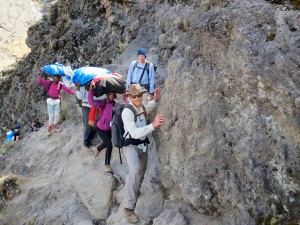
Our porters stuck behind me while I navigate the “kissing rock”; staying in kissing range to avoid sliding into oblivion.
By the fourth day, one of our fellow climbers had been struggling with the altitude and made the wise decision to turn back. We were sorry to see him go, but altitude sickness can become really dangerous, really quickly and it is best not to take chances. So our party of 3 continued on up a rocky scramble that would eventually take us to base camp at 15,000 ft. before we attempted to summit the next day. Along the way, we got some cold rain that hit us just before lunch but, as we climbed, it fortunately turned to snow and allowed us to stay reasonably dry. With the combination of the anticipation of the next day’s summit and the challenge of high altitude, we didn’t get much sleep at all.
When I say we were to summit the “next day”, that belies the total absurdity of what lay ahead. Our bid for the summit would embark at 12:30 am after a “night” of no sleep, so that we could reach the top while the skies were still clear, and hopefully see the sunrise and get the heck back down before any weather rolled in. So we set off for 6 hours of climbing in total darkness, exerting ourselves considerably, but only getting paid back with 25% of the oxygen we would get at sea level. We followed the Swahili Kilimanjaro mantra that was repeated to us over and over on the climb: “pole, pole“; slowly slowly. We were lucky to shuffle along a half-step at a time and we got a 5 minute break every hour or so to try our best to harvest any oxygen we could. It was a very long and grueling morning which was not helped by lack of sleep and lack of appetite. We had sat in on a talk about Kilimanjaro about a year ago and the speaker described his experience thusly, “It consists of 4 days of nice hiking followed by one day of extreme torture.” That sounded about right.
Kilimanjaro is now a dormant volcano, but at the top, a massive crater still remains. We reached the rim of that crater at 5:40am, just as the sun was rising. We saw the world around us bathed in a deep gold and glacier at the top was bending the light into a brilliant array of blues and greens. That sight, coupled with the relief at the end of that hard climb, left me in a sublime state, if only for a few minutes because there was more work ahead.
We climbed another 500 ft. (child’s play at this point) along the rim to the actual summit of the mountain while the rising sun finally warmed my frozen hands and feet. We were in a daze by now and everything felt quite surreal. We finally reached the summit in another hour, snapped all our pictures, and headed out because we still had a long way to go down yet today.
I was completely wiped out after the climb, though Mindy was doing a little better. I remember little of the descent back to base camp and I felt like a zombie forcing myself back down the tough slope. We finally reached camp at 10am where I promptly fell into a dark sleep until I was awoken for lunch. I was completely spent, had no appetite and little sleep, but I managed to have a few slices of watermelon and I began to return to life. We suited up our gear again and continued on a more gradual descent now until we finally arrived at the night’s camp at 5pm.
That day tallied 15 hours of trekking, 4,000 ft. of climbing, and close to 10,000 ft. of descent. Now that it is over, I think it was worth it, for the sights and the experience and the sense of accomplishment, but I cannot imagine choosing to do that again. At least not for a very, very long time.
We had one last day of descent back to the bottom. It was another knee-pounding day of rock steps, but it somehow felt like a relief after the previous day. We were back in the jungles again and there were more monkeys high in the trees around us. They were welcoming sights and, despite the hardships, I was still sad to be going. We reached the bottom and were shuttled back to our hotel where we were presented with a Certificate of Accomplishment and spent the afternoon enjoying a celebratory beer (Kilimanjaro beer, of course).
And if you are considering a visit yourself, hurry up! The glacier on top is shrinking rapidly and is expected to be completely gone by about the year 2020. The glacier at dawn is one of the most spectacular sights I have ever seen and a picture does it little justice.
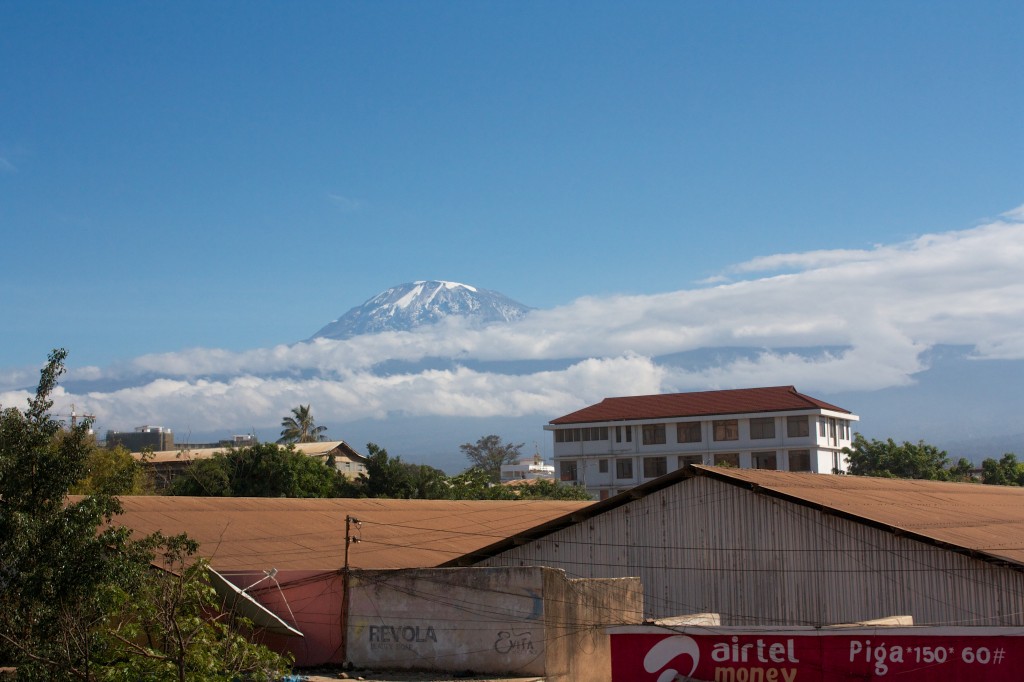
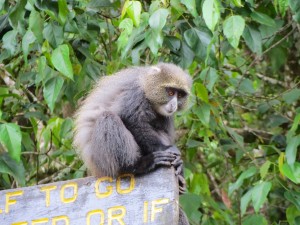
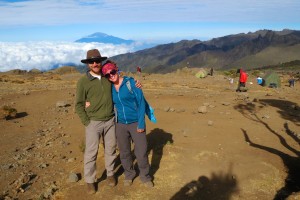
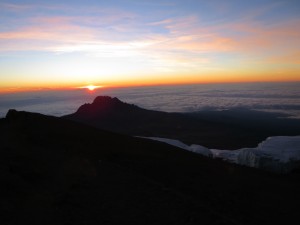
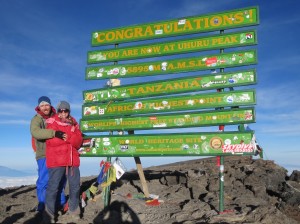
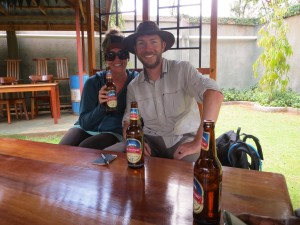
Sound like you picked the right time to go.